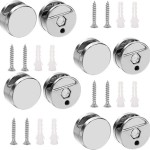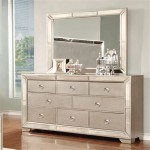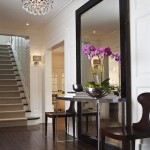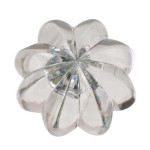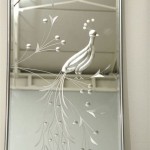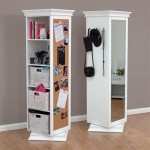Mid-Century Modern Mirrors: Reflecting Style and History
Mid-century modern design, flourishing from the mid-1930s to the mid-1960s, continues to captivate with its clean lines, organic forms, and functional aesthetic. Mirrors, integral to this design movement, served both practical and decorative purposes, enhancing the sense of space and light while contributing to the overall stylistic narrative. These mirrors weren't mere utilitarian objects; they were carefully crafted design elements that reflected the era's emphasis on simplicity and craftsmanship.
Distinctive Shapes and Forms
Mid-century modern mirrors are recognizable for their distinct geometric and organic shapes. Common forms include the iconic starburst, sunburst, and atomic designs, reflecting the era's fascination with space exploration and atomic science. These dynamic shapes often incorporated radiating lines and points, adding a sense of movement and energy to a room. Alongside these bolder designs, simpler geometric shapes like circles, ovals, and rectangles were also prevalent, offering a more understated elegance.
Materials and Construction
Typical materials used in mid-century modern mirror construction included wood, brass, chrome, and glass. Wood frames, often crafted from teak, walnut, or rosewood, provided warmth and organic texture. Metallic elements, like brass and chrome, added a touch of glamour and sophistication, reflecting the era's embrace of new materials and manufacturing techniques. The quality of the glass itself was also a key consideration, with many mirrors featuring high-quality, beveled or smoked glass for added depth and visual interest.
Integration with Furniture and Decor
Mid-century modern mirrors were often designed to complement other furniture pieces within the home. Vanities, dressers, and credenzas frequently incorporated integrated mirrors, creating a cohesive and streamlined look. Wall-mounted mirrors, on the other hand, served as statement pieces, enhancing the overall aesthetic of a room and reflecting the surrounding décor. This integration of mirrors with furniture underscores the mid-century modern emphasis on functionality and holistic design principles.
The Influence of Scandinavian Design
Scandinavian design principles played a significant role in shaping the mid-century modern aesthetic, and this influence is evident in the design of mirrors from the period. The emphasis on clean lines, natural materials, and functional simplicity is a hallmark of both styles. Many mid-century modern mirrors feature minimalist wooden frames or sleek metallic accents, reflecting the Scandinavian emphasis on understated elegance and craftsmanship.
The Rise of the Decorative Mirror
The mid-century modern era saw the rise of the decorative mirror as a key element in interior design. Mirrors were no longer solely utilitarian objects; they became artistic expressions, reflecting the era's optimism and focus on design. Large, statement mirrors with intricate frames or unique shapes served as focal points in living rooms and dining areas, adding a touch of glamour and reflecting the surrounding décor.
Popularity and Resurgence
Mid-century modern mirrors experienced a surge in popularity during the mid-20th century, and their appeal continues to endure today. The timeless elegance and versatility of these mirrors allow them to seamlessly integrate into a variety of contemporary interior design styles. Their ability to enhance natural light and create a sense of spaciousness makes them a practical and stylish addition to any home. The resurgence of interest in mid-century modern design has led to a renewed appreciation for these iconic mirrors, solidifying their place as both functional objects and design classics.
Identifying Authentic Mid-Century Modern Mirrors
When seeking authentic mid-century modern mirrors, certain characteristics can help distinguish them from reproductions. Examining the materials, construction techniques, and overall design can provide clues to a mirror's authenticity. Look for the use of period-specific materials like teak, walnut, or rosewood, as well as details such as brass or chrome accents. The quality of the glass and the presence of beveled edges can also be indicative of an authentic mid-century modern piece. Researching reputable dealers and examining mirrors for signs of age and wear can further aid in authentication.

Mid Century Modern Mirror Geometric Wall Large Wooden
:strip_icc()/cdn.cliqueinc.com__cache__posts__262916__midcentury-modern-mirrors-262916-1531442364113-main.700x0c-7879f4f4ff58442ea8bac9743b6a3c76.jpg?strip=all)
Midcentury Modern Mirrors To Make Your Room Look Bigger

Wallbeyond Mid Century Asymmetrical 20 In W X 25 H Wood Brown Satin Wall Mirror 342103 The Home Depot

10 Mid Century Modern Mirrors To Your Interior Designs Unique Blog

Mid Century Asymmetrical Wood Floor Mirror 28 5 W X 66 H West Elm

Midcentury Brass Wall Mirror Mid Century Modern House Interior Decor

Large Rectangle Mid Century Modern Walnut Wall Mirror For At 1stdibs Midcentury

Mid Century Asymmetrical Wood Wall Mirror 14 Cm X 103 129 West Elm

Stunning Mid Century Modern Mirror Sunburst Wall Starburst Handmade Solid Brass Large 120cms High X 80cms Wide

Mid Century Modern Square Wall Mirror In Solid Brazilian Hardwood Frame 1960s For At Pamono


